
Winscombe is a large village in the North Somerset unitary district of Somerset, South West England, close to the settlements of Axbridge and Cheddar, on the western edge of the Mendip Hills, 7 miles (11 km) southeast of Weston-super-Mare and 14 miles (23 km) southwest of Bristol. The Parish of Winscombe and Sandford, centred on the Parish Church of Church of St James the Great, includes the villages/hamlets of Barton, Hale, Oakridge, Nye, Sidcot and Woodborough.

Rode is a village in the ceremonial county of Somerset in England, 5 miles (8.0 km) northeast of Frome and 5 miles (8.0 km) southwest of Trowbridge.
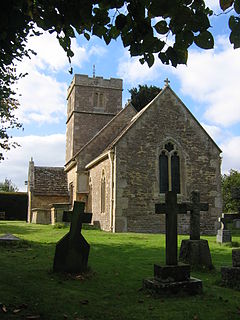
Tellisford is a village and civil parish 6 miles (10 km) north-east of Frome in the Mendip district of Somerset, England. The parish includes the village of Woolverton.
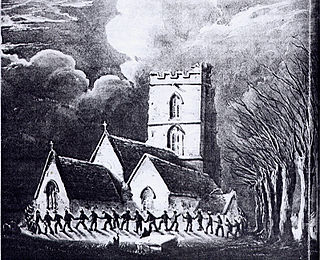
Clipping the church is an ancient custom that is traditionally held in England on Easter Monday or Shrove Tuesday or a date relevant to the Saint associated with the church. The word "clipping" is Anglo-Saxon in origin, and is derived from the word "clyppan", meaning "embrace" or "clasp". Clipping the church involves either the church congregation or local children holding hands in an inward-facing ring around the church, and can then be reversed to an outward-facing ring if a prayer for the wider world beyond the parish is said. Once the circle is completed onlookers will often cheer and sometimes hymns are sung. Often there is dancing. Following the ceremony a sermon is delivered in the church and there are sometimes refreshments. Christians adopted this tradition to show their love for their church and the surrounding people. Currently, there are only a few churches left in England that hold this ceremony, and all of these appear to honour it on a different day.
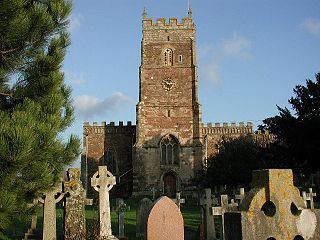
St Mary's Church in Portbury, Somerset, England, is an Anglican parish church close to the M5 motorway. It is a Grade I listed building.

The Church of St Peter in Huish Champflower, Somerset, England dates from the 15th century, with the north aisle being built in 1534. It has been designated by English Heritage as a Grade I listed building.

Church of St Peter, Staple Fitzpaine is Norman in origin, and has been designated as a Grade I listed building.
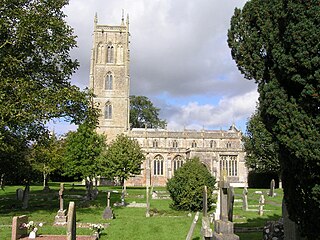
The Church of St Andrew in Cheddar, Somerset, England dates from the 14th century and has been designated as a Grade I listed building.

The Church of St George is a Church of England parish church in Beckington, Somerset, England. It is a Norman church, dating from the 14th century. It has been designated as a Grade I listed building.

St. Mary's Hemington is an Anglican church in Hemington, Somerset, England. The Norman church underwent major renovation in the 14th, 15th, 17th and 19th centuries. The south aisle and nave are the oldest part dating from the 1340s. The tower, was built between 1480 and 1500. The 19th century work is attributed to the office of Sir George Gilbert Scott.

The Church of St Mary the Virgin in Barrington, Somerset, England dates from the 13th century and has been designated as a Grade I listed building.

The Church of St Mary in Ilminster, Somerset, England, dates from the 15th century and has been designated as a Grade I listed building.

The Church of St John the Baptist in Yeovil, Somerset, is a Church of England Parish Church.

The Church of St Michael in Shepton Beauchamp, Somerset, England is built of local hamstone, and has 13th-century origins, although it has been extensively changed since then, with major renovation in 1865 by George Edmund Street. It has been designated as a Grade I listed building.

The Church of St Andrew in Chew Magna, Somerset, England dates from the 12th century with a large 15th-century pinnacled sandstone tower, a Norman font and a rood screen that is the full width of the church. It is a Grade I listed building.

All Saints Church in Castle Cary in the English county of Somerset dates from 1470 and is notable for its high steeple. It is a Grade II* listed building.

The Church of St Philip and St James in Norton St Philip within the English county of Somerset is a Grade II* listed building.

St Michael and All Angels’ Church is a Grade II* listed parish church in the Church of England in East Coker, Somerset.
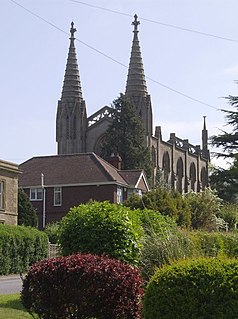
The Anglican Church of St Peter in Rode, within the English county of Somerset, dates from 1824. It is a redundant church and a Grade II* listed building.

The Anglican Church of St Mary in Laverton, Lullington, Somerset, England was built in the 11th century. It is a Grade II* listed building.






















